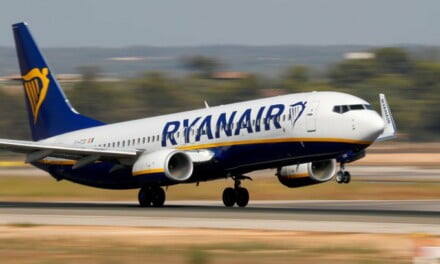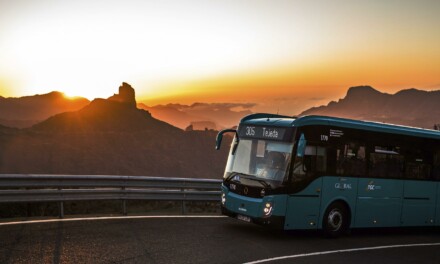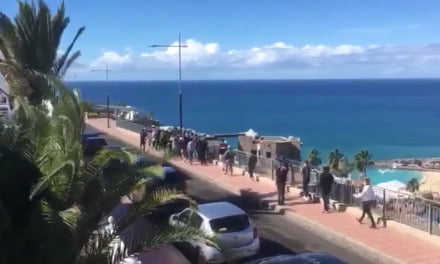The Canary Islands Government are considering up to seven different visions for the future of the El Pajar Port of Santa Águeda (San Bartolomé de Tirajana, in Gran Canaria), the concession for which is held by Cementos Especiales de las Islas (CEISA) at least until October of this year. The industrial cement company aspires to renew its permit to manage the deep water dock that it has held for the last 65 years, while various entities in the tourism sector are demanding the port be given over to recreational use, as it is located in one island’s most privileged areas of coastline, and yet has almost totally avoided tourism exploitation.
. From an original report by Ivan Alexander Hernandez of CanariasAhora
This Wednesday, the Canary Islands’ Governing Council has at last seen the content and conclusions of the long awaited report on the use and potential future of the public domain Port of Santa Águeda, prepared jointly by technicians from the Ministries of Public Works, Tourism and Ecological Transition, after more than a year of meetings with all the stake holders and interested parties. This document, which is not binding, is of vital importance for the future of the otherwise untouched enclave of El Pajar, on which the regional Executive will have to rule on October 22, 2022.
 However, the regional government has not yet revealed the content of the report. Spokesman for the regional Executive, Julio Pérez, explained during a press conference following the Council meeting, that the report will first be presented to the Cabildo de Gran Canaria, to the San Bartolomé de Tirajana Town Council, to the Las Palmas Port Authority and then to the interested parties. These include the cement company itself and, in the tourism sector, Cordial Canarias Hotels & Resorts group (which has already made investments in the area) and the highly influential longstanding Centre for Initiatives and Tourism (CIT), chaired by Fernando del Castillo, of the noble del Castillo family who own the majority of lands in the surrounding areas.
However, the regional government has not yet revealed the content of the report. Spokesman for the regional Executive, Julio Pérez, explained during a press conference following the Council meeting, that the report will first be presented to the Cabildo de Gran Canaria, to the San Bartolomé de Tirajana Town Council, to the Las Palmas Port Authority and then to the interested parties. These include the cement company itself and, in the tourism sector, Cordial Canarias Hotels & Resorts group (which has already made investments in the area) and the highly influential longstanding Centre for Initiatives and Tourism (CIT), chaired by Fernando del Castillo, of the noble del Castillo family who own the majority of lands in the surrounding areas.
“The Government has seen the document, which has been graphically presented by the advisor (of Public Works) Sebastián Franquis and the other advisors, Jose Antonio Valbuena (Ecological Transition) and Yaiza Castilla (Tourism)”, Pérez revealed, explaining that the the report is not yet public because “the prudent thing is for these conclusions to be known first by the administrations involved and by those most affected sectors, even if just for reasons of courtesy and education.”
The Regional Government spokesman indicated that the report sets out “guidelines so that public administrations can make decisions.” In this sense, he outlined “seven designs” are being considered as possible routes for the port, because the technicians who have prepared the document have considered “the alternatives that are physically possible.”
“There are things that cannot be done, like closing the port tomorrow morning; and the things that can physically be done, are not legally possible because urban planning, the regulations on coastal management, do not allow it”, Pérez pointed out. Island planning from 2003 dictates that the port should be for recreational use and not industrial, however, this does not agree with the municipal planning of San Bartolomé de Tirajana, which has not yet been updated.
In any case, Pérez points out that the report, although it contains the word “conclusions”, in fact contains “guidelines so that public administrations can make decisions” on a highly controversial issue with various conflicting interests. But, ultimately, “the Government has the desire to generate consensus around the decision that is finally adopted.”
For its part, the Ministry of Public Works has referred to Pérez’s words at the press conference. “There is nothing more to tell”, he concluded.
 Maintaining industrial use or betting on more tourism
Maintaining industrial use or betting on more tourism
From the tourism sector, the Cordial Canarias Hotels & Resorts group has reportedly invested €50 million in the area, building the Resort Cordial Santa Águeda and the Perchel Beach Club, right next to the cement works. They even went to court expecting the regional government to withdraw CEISA’s port concession in March 2020, but the courts did not agree.
Speaking to the cameras from the Informe Trópico television program some weeks back, Nicolás Villalobos, general director of Cordial Canarias Hotels & Resorts, made the point that if the regional Executive makes a decision to renew CEISA’s concession, it would be an “unlawful” measure, to his mind, and so he did not rule out that, were it to happen, his company suing the government. As for the future of the port, Villalobos showed his preference for converting it into a sports marina similar to the one in Mogán. Of course, he would say that wouldn’t he… he wants tourists staying in his hotel, not cruise ships, let alone cement factories, blocking the view.
 CEISA say they want to maintain what is one of three fundamental pillars supporting their industrial activity, that is, the port through which the raw materials enter, which is complemented by the other two pillars: the factory, located on the company’s own property, and the limestone quarry, the close proximity of which is a major factor in the viability of their business. If they were to lose the concession for the port, Claudio Piernavieja, general coordinator of the company, explained that they would have to transport raw materials by road: “It would mean putting about a hundred trucks a day on the southern highway, which also implies about 3,000 tons of CO2 a year”, he said in an interview broadcast on Informe Trópico.
CEISA say they want to maintain what is one of three fundamental pillars supporting their industrial activity, that is, the port through which the raw materials enter, which is complemented by the other two pillars: the factory, located on the company’s own property, and the limestone quarry, the close proximity of which is a major factor in the viability of their business. If they were to lose the concession for the port, Claudio Piernavieja, general coordinator of the company, explained that they would have to transport raw materials by road: “It would mean putting about a hundred trucks a day on the southern highway, which also implies about 3,000 tons of CO2 a year”, he said in an interview broadcast on Informe Trópico.
On the side of continuing the cement factory concession is the neighbourhood platform called “Save the bay of Santa Águeda” (Salvar la bahía de Santa Águeda), in whose collective opinion supporting the claims of the cement company is equivalent to preventing the little town of El Pajar from becoming a tourist destination similar to Pasito Blanco further east along the same coastline, something that they reject outright.
The progressive mayor of San Bartolomé de Tirajana, Conchi Narváez, has also expressed her support for CEISA to remain in the area, on the basis of historical and emotional reasons, defending the idea that population development in the area has grown hand in hand with the cement company. For this reason, she advocates coexistence between tourism and industry in the area, preserving and showing something more traditional or local, and differentiating El Pajar from all the other tourist offers that the municipality already has.
In this sense, Narváez is patently more in favour of CEISA’s proposal for the port than its reconversion to a recreational dock. Specifically, the company intends to deliver a project to improve the surroundings of El Pajar, with an extension of the shorefront promenade, recreation areas with natural pools to the western side of the factory and the construction of a car park with up to 200 spaces, as well as installing photovoltaic plants in the cement plant itself.
The Government of the Canary Islands, through the Ministry of Public Works, has a lot of hard work ahead of it, to sit down and talk with all the parties and find the most suitable solution, or at least one that generates the greatest consensus. The tourism employers want the cement company to leave and move to an industrial estate, and the company wants to maintain an activity it has carried out in the area since 1957. “The conflict will not end” with the decision made by the regional Executive, says the Mayor of San Bartolomé de Tirajana, since she estimates that “the problem will not be closed, because each group will continue fighting until a final judgment is passed for their position.”










